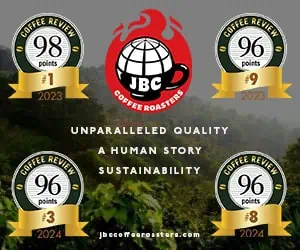LATEST REVIEWS
We have published thousands of coffee reviews and espresso reviews since 1997. The reviews below appear in reverse chronological order by review date. Older reviews may no longer accurately reflect current versions of the same coffee. To search for a specific roaster, origin or coffee use the Advanced Search Function.
A dry, powerful, authoritative cup, rich but not sweet. The ringing energy of the acidity and the substantial body are close to monumental, though lovers of delicacy and nuance may be disappointed.
When hot, the cup is light-bodied but smooth, with a touch of levitating floral-toned fruit that turns sweetly chocolate in the finish. As the cup cools the fruit deepens toward wine and even more distinctly chocolate tones.
Sweet, almost juicy, lemon-and-nut-tones carry exhilaratingly from aroma into the cup. Once there, they turn a bit stolid, then darkens toward tobacco in the finish.
Close to the great Blue Mountains of the past: balanced, round, very rich, almost bouillon-like, with a slight, spicy effervescence tickling at the heart of the cup. Regrettably, a faint, almost undetectable hardness or storage-related fading shadows the otherwise superb cup.
A powerful sweetness transforms the Indonesia pungency into clear dry chocolate tones, enlivened by a touch of acidy brightness. The chocolate tones hint at spice in finish and aftertaste.
A understated but profoundly complex coffee that rewards patience. The nose is restrained, but in the cup a roundly rich pungency is balanced by pronounced sweetness and nuanced by subtle wine tones. The finish is resonant, the aftertaste long, sweet and clean.
I had difficulty deciding whether to honor the inert hardness of this coffee because it's a deliberately achieved characteristic, or condemn it as a defect because I don't find it a particularly pleasant version of the aged taste. The dominating attribute is an oppressively hard pungency that flattens and simplifies the profile. Only a delicate halo of almost subliminal sweetness lightens the cup.
A hard pungency dominates the profile, but it's a rather rich, deep-throated hardness, with undertones of dry spice and a shimmer of sweetness. Possibly an over-aggressive roast burned off some of the sugars, imbalancing the cup.
Another coffee in which the hard tones characteristic of many traditionally processed Indonesian coffees are precariously mellowed by an ingratiating sweetness. The combination of (perhaps musty) sharpness and sweetness hints at chocolate, particularly in the finish.
A hard, baggy pungency. A sweet, soft (perhaps floral) sweetness. When the two work together we get an agreeable sweet/sharp taste that suggests chocolate. The sweet subtext prevails pleasantly in the aftertaste.
A clean Indonesia profile, meaning the pungency is soft rather than oppressively hard and the balancing sweetness is substantial and fresh. An ingratiating and straightforward coffee, though short on nuance.
Another juxtaposition of hard-toned pungency and soft sweetness, although here the sweetness blooms with subtle floral notes in finish and aftertaste. Somewhere in the overlap of hardness and sweetness an additional little nuance emerges, a pleasant spicy tickle.
An unexceptional but comfortable Pacific profile: pungent but not sharp, round, medium-bodied, with a hint of dry, wine-like fruit as the cup cools.
A slight pungency immediately melts in cinnamon-tending sweet spice. The solid (though not hard or heavy) profile retains a consistent character from nose through long, resonant aftertaste. The spice simplifies a bit as the cup cools.
Not a trace of the twisty pungency of most Sumatras and Sulawesis here. Instead a nut-softening-to-vanilla nose, a clear, assertive floral-toned acidity, even a hint of smoke in the finish. With just a little more dimension and sweetness this coffee would be a knockout.
Considerably more emphatic and complex than the Armeno aged Sumatra, apparently owing to the handling of the roast. The same hardness characteristic of many aged Sumatras of recent years is enveloped here with a soft, almost candy-like sweetness, modulating to a dry, tobaccoish finish. Sweet notes prevail in the aftertaste.
One set of palates identified the problem with this Zambia as roughness and harsh acidity. Others, including me, simply read the coffee as underdeveloped. "Flat and woody ... no pulse" said one. "Tired," according to another. Perhaps too many half-ripe cherries carried through to the sample, or perhaps the lightish roast failed to do justice to the coffee. Three of us detected smoky or tobaccoish notes, but none found these tart embellishments particularly attractive.
This coffee provoked an unenviable list of drab adjectives: muddy (the favorite), grassy, neutral, ashy, rubber-like. Four panelists labeled the aftertaste "baggy," a term describing a flat, ropey sensation that usually indicates faulty conditioning or storage. Whatever its origin, the defect here overpowers the coffee.
The brightly assertive, sweetly fruity acidity that Kenya enthusiasts love is on full display here, cradled by a richly textured body. As a bonus we get the treasured Kenya berry notes, although the panel wasn't sure whether they were blueberry, blackberry, strawberry or just "berry." Berries and all, I found this otherwise splendid Kenya a touch shallow in dimension compared to the highest-rated Gaturiri.
A high score but a relatively low wow quotient. Apparently panelists valued this coffee for its rich balance and deeply matrixed fruit; the body was described variously as full, heavy, and thick. However, several panelists felt the cup was a bit faded, restrained, "past-croppish." Perhaps this is an instance when the mid-season timing of the cupping did prejudice the cupping results.











